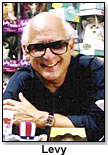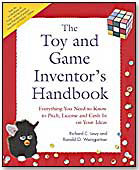 |

Tools:








It’s Not Child’s Play: A Handbook for Toy Inventors20 Dos and Dont's for New Toy and Game Inventors
With additional reporting by Justina Huddleston
 A toy inventor’s path to success today requires hard work, slavish attention to detail, foolhardy tenacity, a bit of luck and above all, an appreciation of the unique market forces that shape the toy industry. Fortunately for those who harbor dreams of turning their ideas into reality, toy industry veterans Richard C. Levy and Ronald O. Weingartner, authors of The Toy and Game Inventor’s Handbook: Everything You Need to Know to Pitch, License and Cash-In on Your Ideas, have some great advice for those thinking of venturing into the toy market. A toy inventor’s path to success today requires hard work, slavish attention to detail, foolhardy tenacity, a bit of luck and above all, an appreciation of the unique market forces that shape the toy industry. Fortunately for those who harbor dreams of turning their ideas into reality, toy industry veterans Richard C. Levy and Ronald O. Weingartner, authors of The Toy and Game Inventor’s Handbook: Everything You Need to Know to Pitch, License and Cash-In on Your Ideas, have some great advice for those thinking of venturing into the toy market.
(For more advice on entering the toy industry, see our interview with Patch Products CEO Bob Wann)
An Ever-Changing Market
The last 15 years have brought dynamic change to the toy industry, and even seasoned toy inventors have been scrambling to find their bearings. While it is still independent inventors who power most of the brightest successes in the lucrative $20-billion+ a year toy industry (Classics  like Pokemon, Cabbage Patch Kids and Etch-a-Sketch are all the brainchildren of independent inventors.), toy inventors today are faced with a diverse set of challenges, according to Levy and Weingartner. like Pokemon, Cabbage Patch Kids and Etch-a-Sketch are all the brainchildren of independent inventors.), toy inventors today are faced with a diverse set of challenges, according to Levy and Weingartner.
A shrinking number of toy companies, coupled with the continued importance of licensing, retailer consolidation and many toy executives’ “hit mentality,” have changed demands on toy inventors. Weingartner says in most cases independent inventors are up against tremendous odds to bring their idea to fruition.
“Consumer product interests are fickle, and costs that marketers will pay for a ‘WOW’ in a toy are often fractional,” he says. “Fortunately, most toy companies are comfortable and receptive to external inventors, and the business has an insatiable annual capacity for new items. Other sectors tend to be insular and restrictive to external inventors.”
The Impact of Licensing
 Though the toy business is relatively friendly to inventors, licensing and market factors have made turning an inventor’s dreams into dollars more difficult than ever before, Levy says. Though the toy business is relatively friendly to inventors, licensing and market factors have made turning an inventor’s dreams into dollars more difficult than ever before, Levy says.
“The toy industry is one of the last and greatest frontiers for the independent inventor. It’s a fashion industry that cannot afford to get caught with its trends down. It has an insatiable appetite for innovative product,” says Levy, who also wrote 2001’s excellent The Complete Idiot's Guide® to Cashing in On Your Inventions. “This having been said, it is no cakewalk. Inventors face all kinds of obstacles ranging from the vicissitudes of the marketplace, technical barriers, costing issues, and at some companies, the “Not Invented Here” syndrome.
(Learn more about designing and submitting toy inventions here)
"When I got into the business 25-plus years ago, it was pure innovation that drove companies, not entertainment licenses,” he says. “Today, the industry almost totally relies on the equity of brands, i.e. marketing products under classic or entertainment licenses. This is why products do not last long. There can be no evergreens when the forest is cut down each year to make room for the next film or TV show.” Licensed toys made up 26% of total toy sales in 2011, according to the NPD Group.
Cashing in on your inventions requires new skills and new ways of dealing with the toy industry, but the only way to succeed is with preparation, hard work and a determination bordering on obsession, Levy and Weingartner say.
“Amateur toy and game inventors become pros the same way amateur athletes do: through training and competition,” they write in the Handbook.
(To learn more about the Handbook, including purchasing information, please go to www.greatideagear.com/toybook.)
Top Tips for New Toy and Game Inventors
By Richard C. Levy and Ronald O. Weingartner
From the book The Toy and Game Inventor’s Handbook: Everything You Need to Know to Pitch, License and Cash-In on Your Ideas
Don’t
1. Don’t hire up-front-fee invention marketing services. Most are confidence schemes, carrion birds that feed on innocent and unsuspecting inventors.
2. Don’t think everyone is out to rip you off. There are two kinds of amateur inventors: the paranoid and the more paranoid.
3. Don’t freak out over signing corporate nondisclosure documents. Sign whatever is fair.
4. Don’t be deterred because you calculate the opposition is too great. You’ll miss 100 percent of the shots you don’t take.
5. Don’t turn technical disagreements into civil wars. Where elephants fight, grass will not grow.
6. Don’t take yourself too seriously. Keep your ego under control.
7. Don’t think you need to make every deal. Sellitus can be hazardous to your mental health and your invention.
8. Don’t bring the artillery until you bring up the ammunition. Get your act together before you make a pitch.
9. Don’t just pitch ideas. Show fully operational prototypes supported by technical and marketing data. They are called “looks-like/works-like” models.
10. Don’t be nervous. Trust yourself. Most of this is common sense.
Do
1. Do a patent search to make sure your idea can be protected, and that it does not infringe another invention.
2. Do your homework on potential licensees. Match your invention with a company’s capabilities.
3. Do market research. Know your market, how to reach it and what need.
4. Do networking. Get business references, especially from other inventors who have licensed concepts to your prospects.
5. Do ask questions. Asking dumb questions is easier than correcting dumb mistakes.
6. Do honest preparations. Nothing astonishes like the truth. Flaunt it.
7. Do trust yourself and your instincts. They are anchors in a storm.
8. Do take risks. The biggest risk is not taking one.
9. Do learn to take rejection. Remember that the finest steel goes through the hottest fire.
10. Do look at the big picture. Frequently you may have to trade short-term security for long-term goals.
THIS BANNER IS AN AD:

Back to TDmonthly's front page
|  |
Advertise on TDmonthly

|

